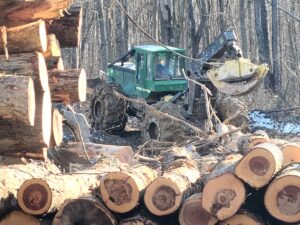
Accidents happen. It’s part of the job. “I was at the wrong place at the wrong time.” There are literally a million excuses people have used to rationalize the reason behind an accident. Let’s get down into the details a little bit and see if we can come up with some common threads to explain why certain accidents continue to happen. This is not to assign blame to anyone in particular, but to see if there is anything that can prevent these accidents in the future—or at least to look at the root causes.
Being in the wood business for many years now, I have seen and been involved in quite a few accidents, and I can say that all of them could have been prevented. The common thread between mine is pretty darn simple. If I would have just taken a few minutes before starting the job at hand to look over the whole situation from start to finish I would have done each one different. So, there is thread number one: taking the time to plan and execute the job. When I was working at the mill, I always carried a small notebook in my pocket. Now, it can easily be done with a cell phone. Taking the time to make a few notes after the job was finished made it more efficient and, as a plus, safer. Some outfits call this a part of their SOP, or standard operating procedure, where the task at hand is outlined from start to finish. Some tasks are as simple as changing saws in a trimmer to changing out bearings on a leveling screw, and everything in-between.
On OSHA’s website, there are several 2022 accidents that are under investigation. This once again shows that logging is a dangerous occupation. Everyone reading this knows exactly what I am talking about in some way! Within a single report, there is a complaint that OSHA investigated and then a follow-up visit. Keep in mind that they are out there doing inspections.
Another common cause of accidents is the lack of maintenance on equipment. It can be rolling stock or stationary. I have visited hundreds of logging sites and more than a few sawmills. In those visits, I have observed machines missing guards, handrails, steps, fire extinguishers, seatbelts, and a host of other things. I have also observed logging sites where the owner took great strides to make sure everything complied. This made for not only a safer work environment, but one where the employees knew their equipment was kept in good working order!
The reason behind most OSHA standards is that somewhere, at some time, a worker was hurt in a way that the standard addresses. Some of these may seem counterproductive to loggers or sawmillers, but the fact remains: people still continue to get hurt. When someone gets hurt, nobody wins. As I did research for this article, I went back a number of years and looked at accidents not only in the wood business, but across the board. It was eye-opening and heartbreaking at the same time to see how many ways people have gotten hurt or killed. The worst part was seeing how many died the same way in states all across the country. Being run over by a piece of equipment is the most common I had read about and learned much about why it continues to happen. It brought back the memory of a good friend who was run over by his own log truck years ago.
If you get anything out of this article, may it be the realization that sometimes we need to look at things through a “different lens,” as the saying goes. If we see people getting hurt in certain ways, we have to take time to look and see what we can do to prevent that in the future. We are in a new year—maybe it is time to start looking at our processes and to come up with a different way. One that is still efficient, but is safer all around!
















